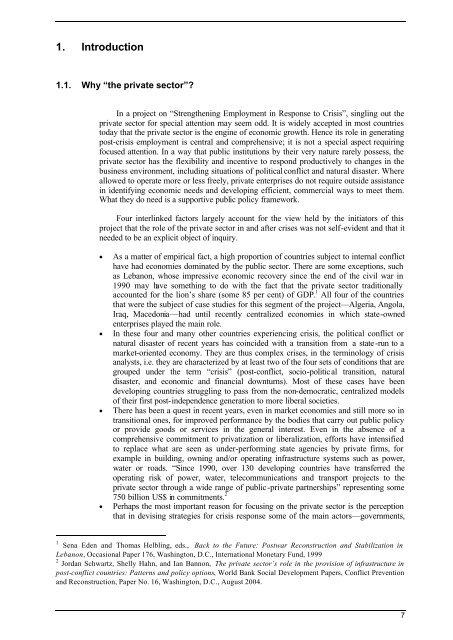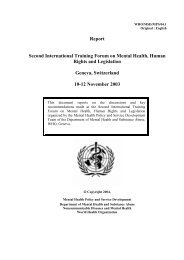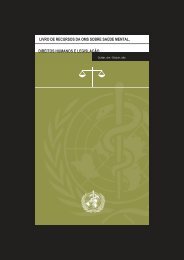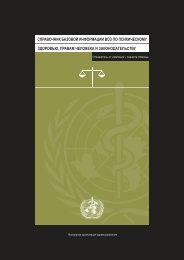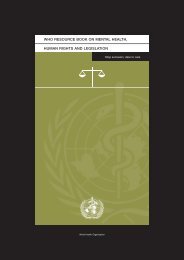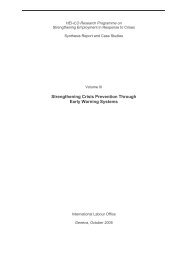Volume 1 Cedric - revised luca Final - RUIG-GIAN
Volume 1 Cedric - revised luca Final - RUIG-GIAN
Volume 1 Cedric - revised luca Final - RUIG-GIAN
You also want an ePaper? Increase the reach of your titles
YUMPU automatically turns print PDFs into web optimized ePapers that Google loves.
1. Introduction1.1. Why “the private sector”?In a project on “Strengthening Employment in Response to Crisis”, singling out theprivate sector for special attention may seem odd. It is widely accepted in most countriestoday that the private sector is the engine of economic growth. Hence its role in generatingpost-crisis employment is central and comprehensive; it is not a special aspect requiringfocused attention. In a way that public institutions by their very nature rarely possess, theprivate sector has the flexibility and incentive to respond productively to changes in thebusiness environment, including situations of political conflict and natural disaster. Whereallowed to operate more or less freely, private enterprises do not require outside assistancein identifying economic needs and developing efficient, commercial ways to meet them.What they do need is a supportive public policy framework.Four interlinked factors largely account for the view held by the initiators of thisproject that the role of the private sector in and after crises was not self-evident and that itneeded to be an explicit object of inquiry.• As a matter of empirical fact, a high proportion of countries subject to internal conflicthave had economies dominated by the public sector. There are some exceptions, suchas Lebanon, whose impressive economic recovery since the end of the civil war in1990 may have something to do with the fact that the private sector traditionallyaccounted for the lion’s share (some 85 per cent) of GDP. 1 All four of the countriesthat were the subject of case studies for this segment of the project—Algeria, Angola,Iraq, Macedonia—had until recently centralized economies in which state-ownedenterprises played the main role.• In these four and many other countries experiencing crisis, the political conflict ornatural disaster of recent years has coincided with a transition from a state-run to amarket-oriented economy. They are thus complex crises, in the terminology of crisisanalysts, i.e. they are characterized by at least two of the four sets of conditions that aregrouped under the term “crisis” (post-conflict, socio-political transition, naturaldisaster, and economic and financial downturns). Most of these cases have beendeveloping countries struggling to pass from the non-democratic, centralized modelsof their first post-independence generation to more liberal societies.• There has been a quest in recent years, even in market economies and still more so intransitional ones, for improved performance by the bodies that carry out public policyor provide goods or services in the general interest. Even in the absence of acomprehensive commitment to privatization or liberalization, efforts have intensifiedto replace what are seen as under-performing state agencies by private firms, forexample in building, owning and/or operating infrastructure systems such as power,water or roads. “Since 1990, over 130 developing countries have transferred theoperating risk of power, water, telecommunications and transport projects to theprivate sector through a wide range of public -private partnerships” representing some750 billion US$ in commitments. 2• Perhaps the most important reason for focusing on the private sector is the perceptionthat in devising strategies for crisis response some of the main actors—governments,1 Sena Eden and Thomas Helbling, eds., Back to the Future: Postwar Reconstruction and Stabilization inLebanon, Occasional Paper 176, Washington, D.C., International Monetary Fund, 19992 Jordan Schwartz, Shelly Hahn, and Ian Bannon, The private sector’s role in the provision of infrastructure inpost-conflict countries: Patterns and policy options, World Bank Social Development Papers, Conflict Preventionand Reconstruction, Paper No. 16, Washington, D.C., August 2004.7


